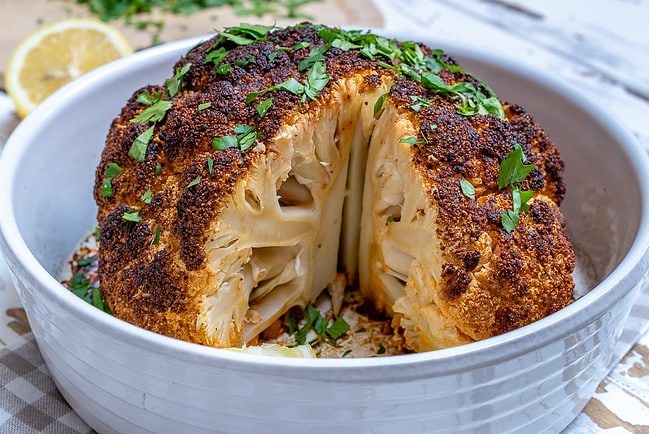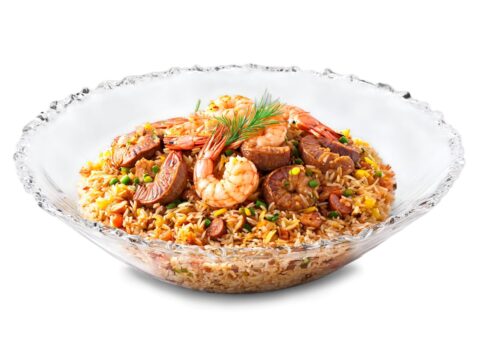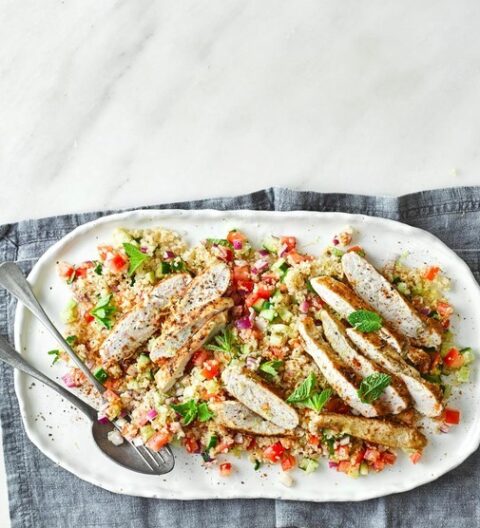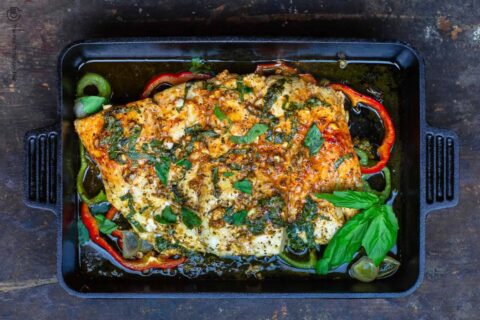
A great Mediterranean diet recipe ‘centrepiece’ dish using extra virgin olive oil to add to your healthy Thanksgiving feast
Whole roasted cauliflower is a sight to behold and never fails to delight, especially when it’s topped with a verdant blend of herbs and pistachios. This version delivers a browned cauliflower that ends up soft enough to serve with a spoon. And it all comes together in one pan, with water added right to the skillet to steam and soften the cauliflower while it roasts over caramelized onions. Sprinkling some Parmesan on top is a nice way to finish this dish.
Roasted Cauliflower & Pistachio Pesto
Ingredients
- 1head cauliflower, preferably orange (about 1½ pounds)
- 2 tablespoons extra-virgin olive oil
- 2 small yellow onions, sliced ¼ inch thick lengthwise
- ¾ teaspoon kosher salt
- Pinch of black pepper
Pesto
- Zest of 1 lemon
- ½ cup lightly packed cilantro and flat-leaf parsley leaves, plus more for garnish
- ¼ cup extra-virgin olive oil
- ¼ cup raw shelled pistachios
- 1 garlic clove, sliced
- ¼ teaspoon kosher salt
- Pinch of black pepper
Instructions
- Make the cauliflower: Position a rack in the centre of the oven and heat oven to 400 degrees. Trim the cauliflower, making sure the stem is cut flush with the head so it sits flat. Heat a 10-inch cast-iron or other heavy ovenproof skillet on the stove over medium heat. Add 1 tablespoon oil, the onions and ¼ teaspoon salt and cook, stirring, until translucent and turning golden on the edges, 7 to 10 minutes. Stir in ¾ cup water and remove from the heat.
- Rub the cauliflower with the remaining tablespoon oil then with the pepper and remaining ½ teaspoon salt. Clear the centre of the skillet and place the cauliflower in it. Cover the pan tightly with foil and place in the centre of the oven. Bake until a paring knife meets no resistance when inserted into the cauliflower, 20 to 30 minutes.
- Meanwhile, make the pesto: Reserve a bit of lemon zest for garnish. Place the rest in a food processor, along with the herbs, oil, pistachios, garlic, salt and pepper. Pulse until well combined.
- Turn oven to 450 degrees on the regular setting or, if you have a convection option, 425 degrees. Uncover the cauliflower and baste with some of the pan juices. Cook, basting occasionally and adding ¼ cup of water to the pan if it threatens to dry out, until nicely browned, 20 to 30 minutes more. Spoon the pesto over top, sprinkle with reserved lemon zest and more herbs, and serve.
What Is Cauliflower?
Cauliflower is a cruciferous vegetable. It’s a member of the mustard family alongside its well-known counterparts of broccoli, Brussels sprouts, kale, and radishes. The word “cauliflower” stems from Latin, meaning “flowers of cabbage” and this low-growing plant does look similar to cabbage until the large leaves begin to open up. This reveals the globe-shaped, cream-colored head that’s about six to eight inches in diameter. The head is made up of bumpy florets attached to the main stem.
Cauliflower is a common vegetable that is very versatile and perhaps best known for its health properties. It has a great ability to blend into its culinary environment, providing body and bulk in low-carb recipes. Cauliflower’s cool-weather ripening and superior storage abilities make it a fall and winter staple for everything from casseroles to soups and it’s found a home in surprising places, including pizza crust.
Cauliflower is naturally high in fiber and B-vitamins. It provides antioxidants and phytonutrients that can protect against cancer. It also contains fiber to enhance weight loss and digestion, choline that is essential for learning and memory, and many other important nutrients.
An article published by the Centers for Disease Control and Prevention (CDC) places cauliflower on a list of “powerhouse fruits and vegetables.”
Benefits Of Cauliflower
Consuming fruits and vegetables of all kinds has been found to reduce the chance of developing many adverse health conditions. Eating more plant foods, such as cauliflower, has been found to decrease the risk of obesity, diabetes, heart disease, and overall mortality while promoting a healthy complexion, increased energy, and overall lower weight.
Digestion
Cauliflower is high in fiber and water. Both are important for preventing constipation, maintaining a healthy digestive tract, and lowering the risk of colon cancer.
Studies have shown that dietary fiber may also help regulate the immune system and inflammation. As a result, it could help decrease the risk of inflammation-related conditions such as cardiovascular disease, diabetes, cancer, and obesity.
A high-fiber intake has been associated with a significantly lower risk of developing:
- coronary heart disease
- stroke
- hypertension
- diabetes
- obesity
- certain gastrointestinal diseases
A higher fiber intake appears to help lower blood pressure and cholesterol levels, improve insulin sensitivity, and enhance weight loss for people with obesity.
Cancer
Cauliflower contains antioxidants that help prevent cellular mutations and reduce oxidative stress from free radicals. One of these antioxidants is indole-3-carbinol or I3C, commonly found in cruciferous vegetables, such as cabbages, broccoli, and cauliflower. It has been shown to reduce the risk of breast and reproductive cancers in men and women.
For the past 30 years, eating more cruciferous vegetables has been associated with a lower risk of and lung and colon cancer. Studies have suggested that sulfur-containing compounds, known as sulforaphane, can help fight different types of cancer. Sulforaphane is what gives cruciferous vegetables their bitter bite.
Researchers say that sulforaphane can inhibit the enzyme histone deacetylase (HDAC), known to be involved in the progression of cancer cells. The scientists are now studying sulforaphane to see if it might delay or impede cancer. So far, there have been promising results for melanoma, esophageal, prostate, and pancreatic cancers.



